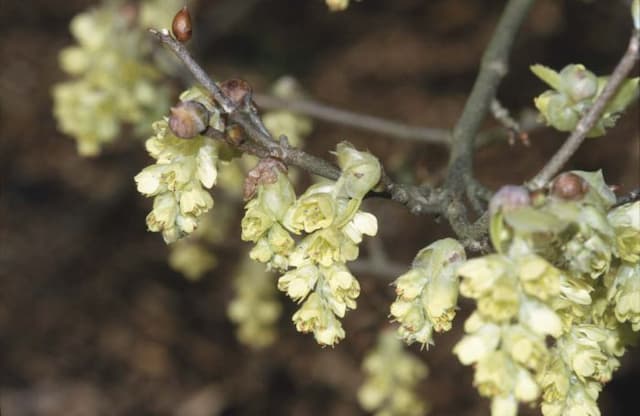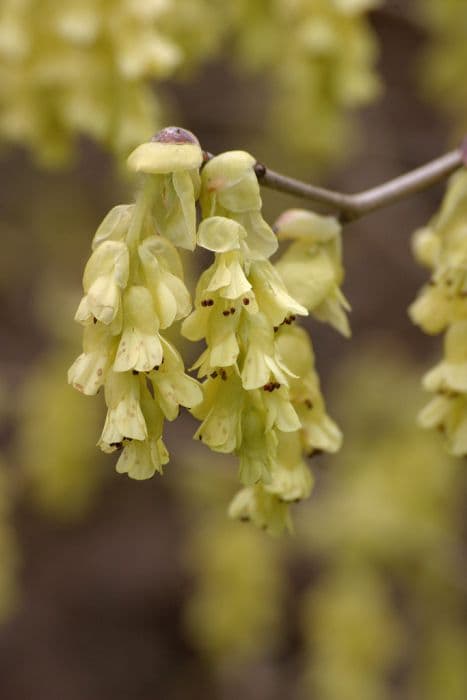Witch Hazel Hamamelis × intermedia 'Diane'

ABOUT
The 'Diane' witch hazel is a visually stunning shrub known for its unique and striking flowers. It possesses a vase-shaped canopy with spreading branches that offer a pleasant architectural form. The leaves of this plant are broad and oval-shaped, with a slightly crinkled texture and a robust green color that catches the eye during the growing season. One of the most captivating aspects of 'Diane' witch hazel is its flowers. They bloom in the late winter to early spring when few other plants are flowering, bringing much-needed color to the garden during the dreary months. The blossoms are distinctive, with long, ribbon-like petals that curl and twist. The color of these petals is a deep, coppery-red to maroon shade, making them stand out against the dark, bare branches of the winter season. As the seasons change, so does the appearance of the 'Diane' witch hazel. In the fall, the foliage undergoes a transformation, turning to vibrant shades of yellow, orange, and red, providing a second display of color before the leaves drop. Overall, the 'Diane' witch hazel is a captivating plant with year-round visual interest, thanks to its unique flowering, attractive foliage, and seasonal color changes. Its ability to bloom during a time when the landscape is often void of color makes it a valuable addition to any garden.
About this plant
 Names
NamesFamily
Hamamelidaceae.
Synonyms
Diane Witch Hazel, Diane Hybrid Witch Hazel.
Common names
Hamamelis × intermedia 'Diane'.
 Toxicity
ToxicityTo humans
Witch hazel 'Diane' is not commonly known to be toxic to humans. However, as with many plants, it is always possible for individuals to experience sensitivity or allergic reactions to plant parts if ingested or when in contact with skin. There are no well-documented reports of serious symptoms or consequences arising from ingesting parts of this plant. It is always recommended to exercise caution and prevent ingestion of ornamental plants not intended for human consumption.
To pets
Witch hazel 'Diane' is not commonly known to be toxic to pets. Similar to humans, there can always be individual cases of pets experiencing sensitivity or allergic reactions if they ingest parts of the plant. No significant toxic effects or symptoms specific to pet poisoning are widely reported for this variety of witch hazel. Nevertheless, it is generally advised to prevent pets from eating ornamental plants as they are not part of a pet's normal diet, and ingestion can potentially lead to gastrointestinal upset or other issues.
 Characteristics
CharacteristicsLife cycle
Perennials
Foliage type
Deciduous
Color of leaves
Green
Flower color
Red
Height
12 feet (3.66 meters)
Spread
12 feet (3.66 meters)
Plant type
Shrub
Hardiness zones
5
Native area
Cultivar
Benefits
 General Benefits
General Benefits- Winter Interest: 'Diane' witch hazel blooms in the late winter, adding color to the garden during a season when few other plants are in flower.
- Attractive Foliage: Its broad, green leaves turn attractive shades of yellow, orange, and red in the fall, providing extended seasonal interest.
- Wildlife Habitat: The plant provides shelter and nesting sites for birds and other wildlife in the landscape.
- Garden Aesthetics: With its unique, ribbon-like flowers and strong structure, 'Diane' witch hazel can serve as a focal point or accent in landscape design.
- Drought Tolerance: Once established, it is relatively drought tolerant, making it suitable for gardens with limited water availability.
- Low Maintenance: This variety of witch hazel requires minimal pruning and is generally low maintenance, suited for gardeners of all skill levels.
- Cold Hardy: It is hardy in a wide range of climates, tolerating cold winters well.
- Pest Resistance: 'Diane' is resistant to many pests and diseases, reducing the need for chemical treatments in the garden.
 Medical Properties
Medical PropertiesThis plant is not used for medical purposes.
 Air-purifying Qualities
Air-purifying QualitiesThis plant is not specifically known for air purifying qualities.
 Other Uses
Other Uses- Photography Prop: Witch Hazel 'Diane' can be used as a striking subject in photography, especially when in full bloom, with its rich coppery-red flowers offering a striking color contrast against winter backdrops.
- Winter Garden Theme: It can contribute to a themed winter garden, where plants are selected for their ability to provide color and texture during the colder months.
- Lunar New Year Decor: Branches of Witch Hazel 'Diane' can be cut and used indoors as a decorative element for Lunar New Year, symbolizing the coming of spring with its early flowers.
- Educational Tool: This plant is useful for educational purposes to demonstrate hybrid vigor and the process of plant hybridization to students and gardening enthusiasts.
- Craft Material: The unique branch structure and colorful blossoms of Witch Hazel 'Diane' can be used in floral crafts and as a natural material for wreaths and garlands.
- Insect Attraction: When in bloom, the plant can serve as an early source of nectar for pollinators, which can be a beneficial element in a wildlife or conservation garden setting.
- Photographic Reference: Artists and illustrators can use the Witch Hazel 'Diane' as a reference model to study and depict the details of flower and plant anatomy in their work.
- Seasonal Indicator: In climate research or citizen science projects, the timing of Witch Hazel 'Diane's flowering period can be used as a phenological indicator of seasonal changes.
- Aromatic Garden Addition: The flowers of Witch Hazel 'Diane' may release a subtle fragrance, which can add an olfactory dimension to a sensory or aromatic garden area.
- Botanical Collections: Witch Hazel 'Diane' can add diversity to botanical collections, arboretums, and educational gardens due to its distinctive flowering time and ornamental value.
Interesting Facts
 Feng Shui
Feng ShuiThe Witch Hazel is not used in Feng Shui practice.
 Zodiac Sign Compitability
Zodiac Sign CompitabilityThe Witch Hazel is not used in astrology practice.
 Plant Symbolism
Plant Symbolism- Hope and New Beginnings: Hamamelis, commonly known as Witch Hazel, often blooms in late winter, a time when most plants are dormant. 'Diane' with its distinct early flowering, symbolizes hope and the promise of new beginnings as it heralds the coming spring.
- Healing and Comfort: Witch Hazel has traditionally been used for its medicinal properties, valued for its soothing and astringent qualities. The 'Diane' variety represents healing and bringing comfort to those in need.
- Protection: Historically, Witch Hazel has been associated with protection. It was believed that planting Witch Hazel near one's home could ward off negative energies. 'Diane', with its robust winter flowering, can be seen as a symbol of steadfast protection.
- Unique Beauty: With its fiery red to copper flowers, 'Diane' stands out from the typical yellow blooms of other Witch Hazel varieties. It symbolizes unique beauty and the appreciation of distinctiveness in a sea of sameness.
- Resilience and Adaptability: 'Diane' demonstrates resilience by enduring the cold winter months and is adaptable in various soil types. This ability to thrive in difficult conditions symbolizes an individual’s capacity to withstand challenges and adapt to changing circumstances.
 Water
WaterWitch Hazel 'Diane' prefers consistent moisture, so it's important to water it regularly but not to overwater. During the first growing season, water the plant deeply once a week with about 1 to 1.5 gallons, ensuring the soil remains moist but well-drained. In subsequent years, you may reduce watering, but during prolonged dry spells, provide supplemental watering to maintain soil moisture. Always check the top few inches of soil for dryness before watering to prevent soggy conditions which can lead to root rot.
 Light
LightWitch Hazel 'Diane' thrives best in full sun to partial shade. Position the plant where it can receive at least 4-6 hours of direct sunlight a day, but also have some shelter from the harsh afternoon sun, especially in warmer climates. An ideal spot could be one that gets morning sun and dappled shade in the afternoon.
 Temperature
TemperatureWitch Hazel 'Diane' is hardy and can tolerate a wide range of temperatures, generally between 10 to 90 degrees Fahrenheit. The plant's ideal growing temperatures are between 60 to 75 degrees Fahrenheit. It can withstand winter chill down to about 10 degrees Fahrenheit and is suitable for USDA hardiness zones 5 through 9.
 Pruning
PruningPruning Witch Hazel 'Diane' is not often necessary but can be done to maintain shape and remove any dead wood. The best time to prune is in late winter or early spring before new growth appears. You may also trim after flowering to avoid cutting off any of the current year's blooms. Pruning can be done annually if shaping is needed or less frequently if just removing dead or damaged branches.
 Cleaning
CleaningAs needed
 Soil
SoilWitch Hazel 'Diane' thrives in well-drained, loamy soil enriched with organic matter. The ideal soil pH for this plant is slightly acidic to neutral, ranging from 5.5 to 7.0. A mix containing equal parts garden soil, peat moss or compost, and perlite or sand will provide the proper environment for healthy growth.
 Repotting
RepottingWitch Hazel 'Diane' is a large shrub and typically does not require repotting as it is most often planted directly in the ground. However, if grown in a container, it should be repotted every 3-5 years, or when it becomes root-bound.
 Humidity & Misting
Humidity & MistingWitch Hazel 'Diane' is adaptable to a wide range of humidity levels, but it performs best in moderate humidity. This plant doesn't require any special humidity adjustments when planted outdoors in its appropriate climate zones.
 Suitable locations
Suitable locationsIndoor
Provide bright light, keep soil moist, and ensure good air circulation.
Outdoor
Plant in partial shade, well-drained soil, and mulch root zone.
Hardiness zone
5-8 USDA
 Life cycle
Life cycleHamamelis × intermedia 'Diane', commonly known as Witch Hazel 'Diane', begins its life cycle as a seed, which germinates in favorable conditions, typically requiring stratification to break dormancy. The seedling grows into a young shrub with characteristic broad green leaves. Over several years, the shrub matures, developing a woody structure and reaching its full size, which can be up to 12 feet tall. Once mature, 'Diane' produces red to coppery orange flowers in late winter to early spring, often while the branches are still bare from the cold season. After pollination, usually by wind or insects, the flowers develop into seed capsules that mature in fall and eject seeds several yards away, continuing the propagation cycle. The plant may also be propagated vegetatively via cuttings, leading to a clone of the parent plant.
 Propogation
PropogationPropogation time
Late winter-early spring
The common witch hazel variety Hamamelis × intermedia 'Diane' is best propagated through softwood cuttings taken in late spring or early summer when new growth is still tender and green. The process involves selecting a healthy shoot, cutting a 4 to 6-inch (10 to 15 centimeters) length, stripping the leaves from the lower half, and dipping the cut end into a rooting hormone. This cutting should then be planted in a well-draining potting mix, ensuring that the leafless portion is buried. To create a humid environment conducive to root development, the potted cutting can be covered with a plastic bag or placed in a propagator. It typically takes several weeks to a few months for the cutting to root, at which point it can be transferred to a larger pot or directly into the garden once it has established a strong root system and the risk of frost has passed.









